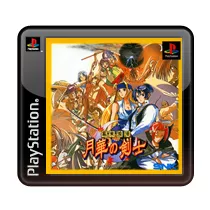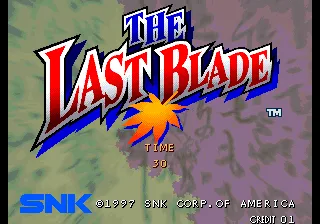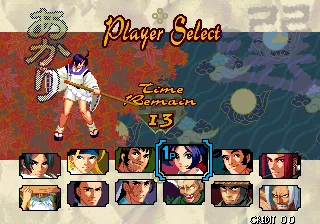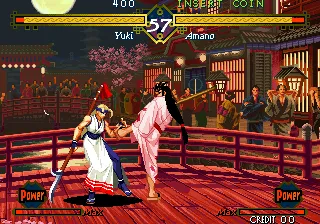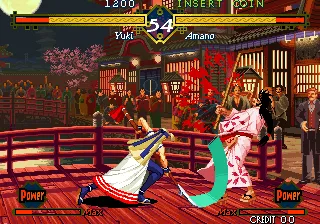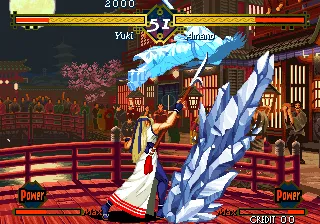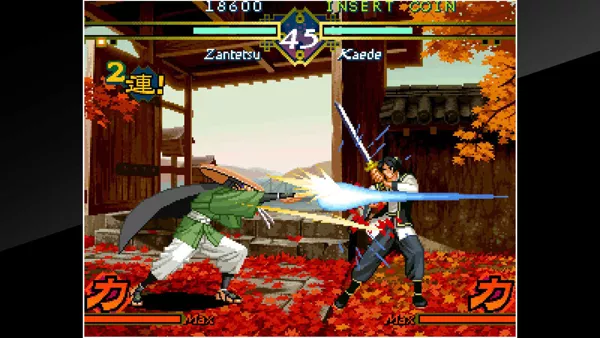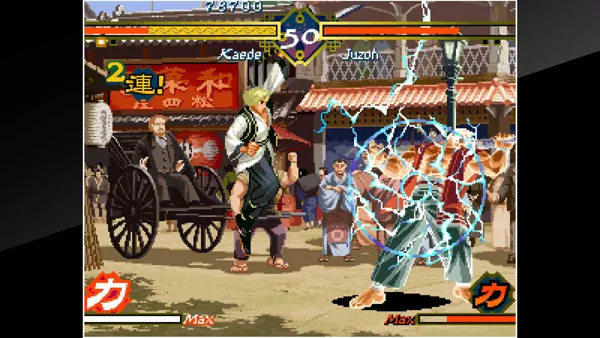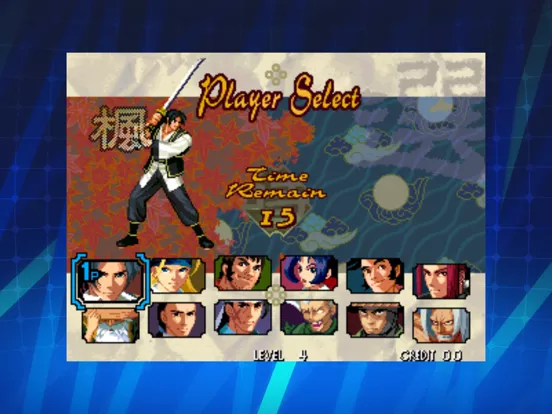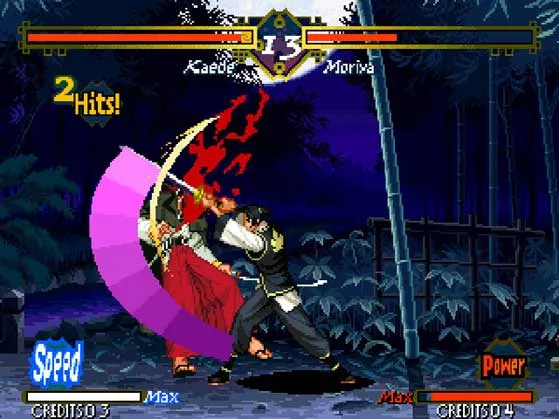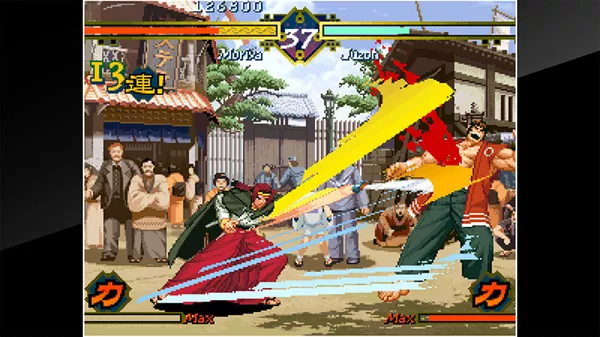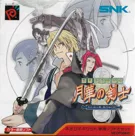The Last Blade
Description official descriptions
Choose one of several characters to play with, each with their own unique moves and special attacks. Each stage in the game has two battles, where the object of each is to drain your opponent's energy in order to complete the battle, and you will complete the stage if you do this twice. If there is a draw, then a third battle is played. There is a time limit, and when this expires, the player with more energy left wins.
Spellings
- 幕末浪漫 月華の剣士 - Japanese spelling
Groups +
Screenshots
Promos
Credits (Neo Geo version)
72 People (61 developers, 11 thanks) · View all
| Kaede |
|
| Amano |
|
| Moriya |
|
| Musashi |
|
| Yuki |
|
| Akari |
|
| Okina |
|
| Shigen |
|
| Juzoh |
|
| Shikyoh |
|
| Washizuka |
|
| Zantetsu |
|
| Kagami |
|
| Lee |
|
| Juzoh / Washizuka Stage |
|
| Lee / Kagami Stage |
|
| Yuki / Shikyo Stage |
|
| Moriya / Zantetsu Stage |
|
| Kaede / Akari Stage |
|
| Amano / Shigen Stage |
|
| [ full credits ] | |
Reviews
Critics
Average score: 89% (based on 9 ratings)
Players
Average score: 3.9 out of 5 (based on 43 ratings with 0 reviews)
Be the first to review this game!
Trivia
Characters
The Last Blade has a lot to do with Japanese religion. (Note: The following section is written from a perspective of having little understanding of Japanese culture).
There are four gods in Japanese mythology : Seiryuu (blue dragon), Suzaku (red phoenix), Byakko (white tiger), and Genbu. Each of the gods are associated with a direction : Byakko with west, Seiryuu with east, Genbu with north and Suzaku with the south. The four gods also seem to be portrayed in an identical manner : Suzaku is often seen as a renegade of sorts, Genbu is often wise, Byakko seems to be strong, and Seiryuu seems to be the role of the protagonist.
To this end, Kaede, Okina, Shigen, and Kagumi, the four characters who are avatars to these gods in Gekka no Kenshi seem to fit the gods themselves. (Kaede to Seiryuu, Okina to Genbu, Shigen to Byakko and Kagami to Suzaku.) However, there may be one, unintentional reference to the entire fighting genre itself. These four characters may very well represent the four popular styles of characters found in nearly every fighting game:
Kaede is a Shotokan-style character. This type of character is the earliest type of fighting game character (as early fighting games always had the protagonist be proficient in some form of karate). However, ever since the release of Street Fighter II: The World Warrior, a Shoto-character refers to a character with similar moves to that of Ryu and Ken from that game, or more specifically, a character with a projectile and a built upper. Kaede fits this property well : his Ittou Hayate is a projectile (much like Ryu's Hadou Ken) and his Ittou Kuuga is a built upper (like Ken's Shoryuu Ken). Of course, Kaede may also be a nod to that of SNK's first fighting game protagonist (Terry Bogard) as well : his Kasshin Fukuryuu super is in the style of Terry's Power Geyser. To this day, many fighting game characters are known as Shoto characters - their simplicity can't be beat.
Shigen is a large character. Large characters come generally in two flavors : the power character and the grappler (Shigen himself is a mix of both). Power characters generally don't move much but deal lots of damage per hit. Grapplers are those whose special moves are mainly throws. These characters tend to last longer because of their size, but have a weakness that they have either short range or are slow (or, in the case of some characters, overly complicated moves).
Okina may be described as a turtler. This may seem like an inside joke (Okina, in his profile, refers to his family as a bunch of turtles), but it sometimes make sense. Jokes aside, turtlers are not exactly a type of character, but a type of player. That is, a turtler is a player who tend to block attacks a lot. Charge characters (ie. those whose repertoire of moves are mainly charge moves) generally fall into this category, as it is often that they need to remain in a blocking position in order to get their charges and counterattack.Over the years, there have been many incentives to stray away from this style (as well as derivatives thereof, such as ticking), such as guard breaks, overheads, low attacks, shorter charges and unblockable moves. Granted, the turtler is not as big as a factor as it used to be (the most popular character in Street Fighter II: The World Warrior was Guile because of his turtling and ticking abilities), but Okina's reference to turtles remains.
Kagami, of course, continues SNK's tradition of making cheap-ass characters for final bosses.
Culture
Japan's Bakumatsu period (1860-1899) represents the opening of Japanese ports to foreigners. The Last Blade is set during this time period and you can see Europeans in some backgrounds, as well as some European dress influences on some characters.
References
Both Akari and Juzoh are the comedic relief characters in the Gekka series. Juzoh can be seen in Akari's stage if Akari is fighting (and obviously, if Akari is not fighting Juzoh). Akari can be seen in Juzoh's stage if Juzoh is fighting (and if Juzoh isn't fighting against Akari).
Title translation
The Japanese title translates to "Bakumatsu Romance: Swordsman In The Moonlight".
Analytics
Related Sites +
-
Wikipedia: The Last Blade
Information about The Last Blade at Wikipedia
Identifiers +
Contribute
Are you familiar with this game? Help document and preserve this entry in video game history! If your contribution is approved, you will earn points and be credited as a contributor.
Contributors to this Entry
Game added by Katakis | カタキス.
PS Vita added by Fred VT. Neo Geo CD added by Corn Popper. PlayStation 4 added by mars_rulez. Arcade, Windows, Browser, Macintosh, Linux added by 666gonzo666. Android, Xbox One, iPad, iPhone, Nintendo Switch added by Rik Hideto. PSP, Wii, Blacknut, PlayStation 3 added by Sciere. Windows Apps added by Foxhack. PlayStation added by Freeman.
Additional contributors: DreinIX, Patrick Bregger, yenruoj_tsegnol_eht (!!ihsoy).
Game added April 21, 2005. Last modified March 31, 2025.


